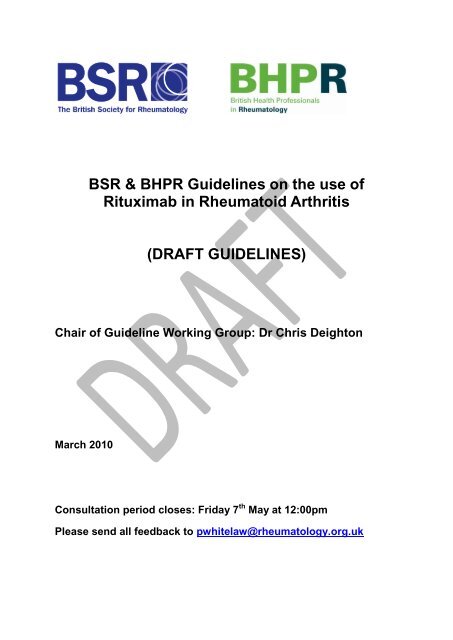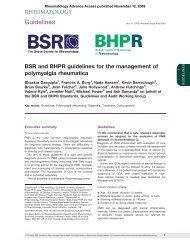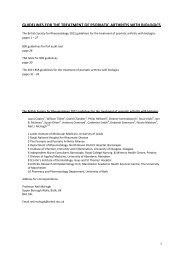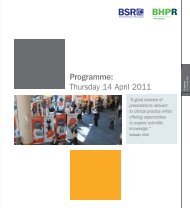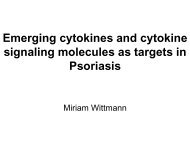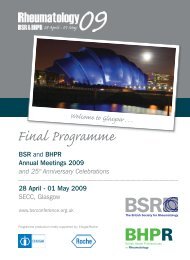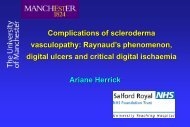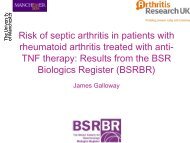BSR & BHPR Guidelines on the use of Rituximab in Rheumatoid ...
BSR & BHPR Guidelines on the use of Rituximab in Rheumatoid ...
BSR & BHPR Guidelines on the use of Rituximab in Rheumatoid ...
Create successful ePaper yourself
Turn your PDF publications into a flip-book with our unique Google optimized e-Paper software.
<str<strong>on</strong>g>BSR</str<strong>on</strong>g> & <str<strong>on</strong>g>BHPR</str<strong>on</strong>g> <str<strong>on</strong>g>Guidel<strong>in</strong>es</str<strong>on</strong>g> <strong>on</strong> <strong>the</strong> <strong>use</strong> <strong>of</strong><br />
<strong>Rituximab</strong> <strong>in</strong> <strong>Rheumatoid</strong> Arthritis<br />
(DRAFT GUIDELINES)<br />
Chair <strong>of</strong> Guidel<strong>in</strong>e Work<strong>in</strong>g Group: Dr Chris Deight<strong>on</strong><br />
March 2010<br />
C<strong>on</strong>sultati<strong>on</strong> period closes: Friday 7 th May at 12:00pm<br />
Please send all feedback to pwhitelaw@rheumatology.org.uk
Cl<strong>in</strong>ical Affairs Committee<br />
& Standards, Audit and <str<strong>on</strong>g>Guidel<strong>in</strong>es</str<strong>on</strong>g> Work<strong>in</strong>g Group<br />
Marwan Bukhari 1 , Rikki Abernethy 2, Chris Deight<strong>on</strong> 3 , T<strong>in</strong>a D<strong>in</strong>g 3 , Kimme Hyrich 4 , Mark Lunt 4 ,<br />
Raashid Luqmani 5 , Patrick Kiely 6 , , Ailsa Bosworth 7 , Jo Led<strong>in</strong>gham 8 , Andrew Ostor 9 , Kate<br />
Gadsby 1 , Frank McKenna 10 , Diana F<strong>in</strong>ney 11 , Josh Dixey 12<br />
1. Rheumatology Department, Royal Lancaster Infirmary, Lancaster<br />
2. Rheumatology Department, St Helens Hospital, St Helens<br />
3. Rheumatology Department, Derbyshire Royal Infirmary, Derby<br />
4. ARC Epidemiology Unit, University <strong>of</strong> Manchester<br />
5. Rheumatology Department, Nuffield Orthopaedic Centre, Oxford<br />
6. Rheumatology Department, St George’s Healthcare, L<strong>on</strong>d<strong>on</strong><br />
7. Nati<strong>on</strong>al <strong>Rheumatoid</strong> Arthritis Society, Maidenhead<br />
8. Rheumatology Unit, Queen Alexandra Hospital, Portsmouth<br />
9. Rheumatology Department, Addenbrooke’s Hospital, Cambridge<br />
10. Trafford General Hospital, Manchester<br />
11. Rheumatology Unit, Worth<strong>in</strong>g and Southlands NHS Trust<br />
12. Robert J<strong>on</strong>es and Agnes Hunt Orthopaedic Hospital, Oswestry
Introducti<strong>on</strong> and Objectives<br />
1.1 Why do we need <strong>Rheumatoid</strong> Arthritis <strong>Rituximab</strong> <str<strong>on</strong>g>Guidel<strong>in</strong>es</str<strong>on</strong>g>?<br />
The Standards, audit and guidel<strong>in</strong>es work<strong>in</strong>g group (SAGWAG) have recently updated <strong>the</strong><br />
guidel<strong>in</strong>es <strong>on</strong> eligibility for anti-TNF drugs <strong>in</strong> rheumatoid arthritis (RA) [1] and have updated<br />
<strong>the</strong> anti-TNF safety and efficacy guidel<strong>in</strong>es [2]. NICE technology appraisal guidance [3] for<br />
<strong>use</strong> <strong>of</strong> <strong>Rituximab</strong> <strong>in</strong> <strong>Rheumatoid</strong> Arthritis and a c<strong>on</strong>sensus statement from EULAR [4] were<br />
published <strong>in</strong> 2007. Therefore, it is appropriate to undertake a review <strong>of</strong> <strong>the</strong> currently<br />
available data. The group does not wish to duplicate <strong>the</strong> guidance <strong>in</strong> those documents, but<br />
wishes to review <strong>the</strong> more recent evidence and supplement what is already known.<br />
1.2 Objective <strong>of</strong> guidel<strong>in</strong>es<br />
To update <strong>the</strong> <strong>in</strong>formati<strong>on</strong> provided <strong>in</strong> NICE guidance [3] , and EULAR c<strong>on</strong>sensus statement<br />
<strong>on</strong> <strong>use</strong> <strong>of</strong> <strong>Rituximab</strong> <strong>in</strong> patient with rheumatoid arthritis published <strong>in</strong> January 2007 [4].<br />
1.3 Target audience<br />
The primary target audience for this guidel<strong>in</strong>e is rheumatologists, rheumatology specialist<br />
registrars and rheumatology nurse specialist/practiti<strong>on</strong>ers <strong>in</strong>volved <strong>in</strong> <strong>the</strong> management <strong>of</strong><br />
patients with <strong>Rheumatoid</strong> Arthritis. The <strong>in</strong>formati<strong>on</strong> may also be <strong>of</strong> value to o<strong>the</strong>r sec<strong>on</strong>dary<br />
care and primary care physicians whose patients may be receiv<strong>in</strong>g this treatment for<br />
<strong>Rheumatoid</strong> Arthritis.<br />
1.4 The areas <strong>the</strong> guidel<strong>in</strong>e does not cover<br />
This guidel<strong>in</strong>e does not cover <strong>the</strong> <strong>use</strong> <strong>of</strong> rituximab <strong>in</strong> treatment <strong>of</strong> o<strong>the</strong>r rheumatological<br />
c<strong>on</strong>diti<strong>on</strong>s apart from <strong>Rheumatoid</strong> Arthritis<br />
1.5 Stakeholder <strong>in</strong>volvement<br />
Patients have not been <strong>in</strong>volved <strong>in</strong> <strong>the</strong> producti<strong>on</strong> <strong>of</strong> <strong>the</strong>se guidel<strong>in</strong>es but <strong>the</strong> guidel<strong>in</strong>es<br />
have been reviewed by members <strong>of</strong> NRAS<br />
1.6 C<strong>on</strong>flict <strong>of</strong> <strong>in</strong>terest statement<br />
RA holds departmental sp<strong>on</strong>sorship from Roche, Wyeth, Abbott and Scher<strong>in</strong>g Plough for<br />
academic meet<strong>in</strong>gs. Pers<strong>on</strong>al sp<strong>on</strong>sorship from Wyeth, Abbott and UCB to attend<br />
<strong>in</strong>ternati<strong>on</strong>al educati<strong>on</strong>al meet<strong>in</strong>gs, is <strong>in</strong>volved with commercial trial recruitment <strong>in</strong> RA from<br />
Roche and has previously sat <strong>on</strong> an advisory board for Roche<br />
MB has attended meet<strong>in</strong>gs organised by Scher<strong>in</strong>g Plough, has been sp<strong>on</strong>sored to attend<br />
<strong>in</strong>ternati<strong>on</strong>al meet<strong>in</strong>gs by Pfizer, Merck ,Roche, Wyeth and Abbott, and has accepted<br />
h<strong>on</strong>oraria for educati<strong>on</strong>al meet<strong>in</strong>gs from Merck, Wyeth, Abbott, Roche, UCB celltech and<br />
Pfizer. He has also departmental sp<strong>on</strong>sorship for s<strong>of</strong>tware from Wyeth, Abbott and Roche.<br />
O<strong>the</strong>r c<strong>on</strong>tributors c<strong>on</strong>flict <strong>of</strong> <strong>in</strong>terest statement are at <strong>the</strong> end <strong>of</strong> this manuscript.
1.7 Rigour <strong>of</strong> development<br />
Statement <strong>of</strong> scope <strong>of</strong> literature search and strategy <strong>in</strong>volved.<br />
The current NICE eligibility and resp<strong>on</strong>se criteria were reviewed [3], and evidence was<br />
sought to determ<strong>in</strong>e whe<strong>the</strong>r <strong>the</strong>se should be modified and also whe<strong>the</strong>r <strong>the</strong>re was evidence<br />
available to update <strong>the</strong> EULAR c<strong>on</strong>sensus statement [4] particularly regard<strong>in</strong>g safety issues.<br />
This evidence was sought through a medl<strong>in</strong>e search us<strong>in</strong>g key words “rituximab” and<br />
“rheumatoid arthritis” to identify English language articles published prior to April 2010 and<br />
also a manual search <strong>of</strong> databases from <str<strong>on</strong>g>BSR</str<strong>on</strong>g>, EULAR and ACR annual meet<strong>in</strong>gs <strong>in</strong> 2007,<br />
2008 and 2009.<br />
Evidence was graded accord<strong>in</strong>g to <strong>the</strong> strength <strong>of</strong> <strong>the</strong> literature to support each statement,<br />
us<strong>in</strong>g <strong>the</strong> grad<strong>in</strong>g suggested by <strong>the</strong> Royal College <strong>of</strong> Physicians <strong>of</strong> L<strong>on</strong>d<strong>on</strong><br />
(http://www.rcpl<strong>on</strong>d<strong>on</strong>.ac.uk/college/ceeu/c<strong>on</strong>ciseGuidel<strong>in</strong>eDevelopmentNotes.pdf) and <strong>the</strong><br />
document was prepared <strong>in</strong> accordance with <strong>the</strong> pr<strong>in</strong>ciples outl<strong>in</strong>ed <strong>in</strong> <strong>the</strong> Appraisal <strong>of</strong><br />
<str<strong>on</strong>g>Guidel<strong>in</strong>es</str<strong>on</strong>g> Research and Evaluati<strong>on</strong> (AGREE) guidel<strong>in</strong>es (www.agreecollaborati<strong>on</strong>.org).<br />
1.8 Statement <strong>of</strong> when guidel<strong>in</strong>e with be updated<br />
In 3 years or earlier if significant <strong>in</strong>formati<strong>on</strong> <strong>on</strong> <strong>use</strong> <strong>of</strong> rituximab <strong>in</strong> treatment <strong>of</strong> patients with<br />
rheumatoid arthritis becomes available before that date.<br />
1.9 How will <strong>the</strong>se guidel<strong>in</strong>es be publicised and implemented?<br />
The full guidel<strong>in</strong>es will be published <strong>on</strong> <strong>the</strong> <str<strong>on</strong>g>BSR</str<strong>on</strong>g> web-site, and sent to all <str<strong>on</strong>g>BSR</str<strong>on</strong>g> members and<br />
Primary Care Trusts. A summary <strong>of</strong> <strong>the</strong> guidel<strong>in</strong>es will be published <strong>in</strong> Rheumatology, with<br />
web l<strong>in</strong>ks to <strong>the</strong> full guidel<strong>in</strong>es. Implementati<strong>on</strong> <strong>of</strong> some parts will depend <strong>on</strong> negotiati<strong>on</strong>s<br />
with NICE, whereas aspects <strong>of</strong> safety can be implemented <strong>on</strong> publicati<strong>on</strong>.<br />
1.10 Cost implicati<strong>on</strong>s<br />
A detailed health ec<strong>on</strong>omic analysis is bey<strong>on</strong>d <strong>the</strong> scope <strong>of</strong> <strong>the</strong>se guidel<strong>in</strong>es. No fund<strong>in</strong>g has<br />
been received to assist with <strong>the</strong> development <strong>of</strong> <strong>the</strong>se guidel<strong>in</strong>es,<br />
The guidel<strong>in</strong>es<br />
The current NICE eligibility and resp<strong>on</strong>se criteria were reviewed, and evidence was sought<br />
to determ<strong>in</strong>e whe<strong>the</strong>r <strong>the</strong>se should be modified. An update <strong>on</strong> safety aspects based <strong>on</strong> <strong>the</strong><br />
<strong>in</strong>creas<strong>in</strong>g experience <strong>of</strong> this drug was performed to advise colleagues regard<strong>in</strong>g toxicity and<br />
<strong>the</strong> safe <strong>use</strong> <strong>of</strong> <strong>the</strong> drug.<br />
1. Eligibility and resp<strong>on</strong>se criteria<br />
Current NICE guidel<strong>in</strong>es [3] state that rituximab should be <strong>use</strong>d<br />
a. with methotrexate<br />
b. <strong>in</strong> patients who have had an <strong>in</strong>adequate resp<strong>on</strong>se to or <strong>in</strong>tolerance <strong>of</strong> o<strong>the</strong>r<br />
DMARDs, <strong>in</strong>clud<strong>in</strong>g treatment with at least <strong>on</strong>e anti-TNF <strong>the</strong>rapy<br />
c. by specialist physicians experienced <strong>in</strong> diagnosis and treatment <strong>of</strong><br />
rheumatoid arthritis
d. It should be c<strong>on</strong>t<strong>in</strong>ued <strong>on</strong>ly if patients show an improvement <strong>in</strong> disease<br />
activity <strong>of</strong> 1.2 po<strong>in</strong>ts or more.<br />
e. Repeat courses should be given with methotrexate and no more than 6<br />
m<strong>on</strong>thly.<br />
The group discussed this and raised several questi<strong>on</strong>s after scrut<strong>in</strong>is<strong>in</strong>g <strong>the</strong> current<br />
evidence:<br />
i. Can rituximab be given without o<strong>the</strong>r DMARDs, or with alternatives to<br />
methotrexate?<br />
ii. Can rituximab be given before anti-TNF <strong>the</strong>rapy, and are <strong>the</strong>re any particular<br />
categories <strong>of</strong> RA patients who might benefit from such an approach?<br />
iii. Should <strong>the</strong> eligibility and resp<strong>on</strong>se criteria be modified?<br />
iv. Should <strong>the</strong> suggested frequency <strong>of</strong> repeat <strong>in</strong>fusi<strong>on</strong>s be modified?<br />
i. Can rituximab be given without o<strong>the</strong>r DMARDs, or with alternatives to methotrexate?<br />
Recommendati<strong>on</strong> 1: If methotrexate is c<strong>on</strong>tra-<strong>in</strong>dicated, rituximab should be <strong>use</strong>d <strong>in</strong><br />
rheumatoid arthritis ei<strong>the</strong>r al<strong>on</strong>e, or with leflunomide.<br />
(Level III evidence, grade <strong>of</strong> recommendati<strong>on</strong> B)<br />
The <strong>in</strong>itial pro<strong>of</strong> <strong>of</strong> c<strong>on</strong>cept trial [5] <strong>in</strong>cluded cyclophosphamide or methotrexate as <strong>the</strong><br />
c<strong>on</strong>comitant treatment. 161 patients were randomised. Although this was <strong>the</strong> <strong>in</strong>itial open<br />
label trial, little difference existed between those treated with methotrexate and rituximab and<br />
those treated with cyclophosphamide and rituximab. In this trial, rituximab was also <strong>use</strong>d as<br />
m<strong>on</strong>o<strong>the</strong>rapy with good efficacy, but this did not achieve significance versus placebo due to<br />
<strong>the</strong> small numbers <strong>in</strong> each group. The percentage figures for efficacy at 24 weeks are<br />
summarised <strong>in</strong> <strong>the</strong> table below.<br />
Strategy<br />
% achiev<strong>in</strong>g<br />
ACR20<br />
% achiev<strong>in</strong>g<br />
ACR50<br />
% achiev<strong>in</strong>g<br />
ACR70<br />
Methotrexate 38 13 5<br />
<strong>Rituximab</strong> al<strong>on</strong>e 65 33 15<br />
Cyclophosphamide<br />
and rituximab<br />
Methotrexate and<br />
rituximab<br />
76 41 15<br />
73 43 23<br />
Table 1 . Efficacy <strong>of</strong> rituximab when <strong>use</strong>d with a variety <strong>of</strong> o<strong>the</strong>r c<strong>on</strong>comitant medicati<strong>on</strong>s <strong>in</strong><br />
161 patients [5]
Recent data has suggested <strong>the</strong> possible role for leflunomide <strong>in</strong> patients <strong>in</strong>tolerant <strong>of</strong><br />
methotrexate [6]. There is very little data available regard<strong>in</strong>g <strong>the</strong> comb<strong>in</strong>ati<strong>on</strong> <strong>of</strong> rituximab<br />
with o<strong>the</strong>r biologic <strong>the</strong>rapies. In a small study with <strong>on</strong>ly 18 patients [7], patients were treated<br />
with etanercept and rituximab with good efficacy and no apparent significant <strong>in</strong>crease <strong>in</strong> side<br />
effects with <strong>the</strong> etanercept disc<strong>on</strong>t<strong>in</strong>ued a week before, and recommenced a week after <strong>the</strong><br />
<strong>in</strong>fusi<strong>on</strong>s. However, comb<strong>in</strong>ati<strong>on</strong> <strong>of</strong> o<strong>the</strong>r biologics has been associated with <strong>in</strong>creased<br />
<strong>in</strong>cidence <strong>of</strong> side effects, particularly <strong>in</strong>fecti<strong>on</strong>s, without <strong>in</strong>crease <strong>in</strong> efficacy and <strong>the</strong>refore<br />
this area requires fur<strong>the</strong>r research before any recommendati<strong>on</strong> can be made,<br />
ii. Can rituximab be given before anti-TNF <strong>the</strong>rapy, and are <strong>the</strong>re any particular categories <strong>of</strong><br />
RA patients who might benefit from such an approach?<br />
Recommendati<strong>on</strong> 2: <strong>Rituximab</strong> could be given <strong>in</strong> rheumatoid arthritis before anti-TNF<br />
treatment, particularly <strong>in</strong> patients who have an absolute or relative c<strong>on</strong>tra-<strong>in</strong>dicati<strong>on</strong><br />
to anti-TNF <strong>the</strong>rapy.<br />
(Level Ib evidence, grade <strong>of</strong> recommendati<strong>on</strong> A)<br />
In observati<strong>on</strong>al data from <strong>the</strong> Swiss biologics register it was suggested that resp<strong>on</strong>se to<br />
rituximab is better after <strong>the</strong> failure <strong>of</strong> <strong>the</strong> first anti-TNF agent, ra<strong>the</strong>r than switch<strong>in</strong>g to a<br />
sec<strong>on</strong>d anti-TNF drug [8]. This supports <strong>the</strong> current NICE guidel<strong>in</strong>es <strong>on</strong> <strong>the</strong> current<br />
sequenc<strong>in</strong>g <strong>of</strong> biological <strong>the</strong>rapy. However, are <strong>the</strong>re any data to support <strong>the</strong> <strong>use</strong> <strong>of</strong><br />
rituximab prior to <strong>the</strong> failure <strong>of</strong> an anti-TNF agent? A dose rang<strong>in</strong>g study ascerta<strong>in</strong>ed patients<br />
between <strong>the</strong> ages <strong>of</strong> 18 and 80 with moderate to severe active RA despite <strong>on</strong>go<strong>in</strong>g<br />
treatment with MTX 10-25 mg per week (orally or parenterally) (acr<strong>on</strong>ym DANCER [9]). Two<br />
thirds <strong>of</strong> patients had not had treatment with a prior biologic. These patients had a<br />
numerically higher ACR20 resp<strong>on</strong>se than those who had been <strong>on</strong> a previous anti-TNF<br />
<strong>the</strong>rapy. An observati<strong>on</strong>al study from Leeds supported <strong>the</strong> efficacy <strong>of</strong> rituximab after<br />
c<strong>on</strong>venti<strong>on</strong>al DMARD failure, and prior to exposure to anti-TNF <strong>the</strong>rapy [10]. The efficacy<br />
and safety <strong>of</strong> rituximab as first-l<strong>in</strong>e biologic <strong>the</strong>rapy <strong>in</strong> patients with active rheumatoid<br />
arthritis is specifically be<strong>in</strong>g <strong>in</strong>vestigated <strong>in</strong> <strong>the</strong> SERENE and MIRROR The <strong>in</strong>itial data from<br />
<strong>the</strong>se studies has been presented as abstracts at ACR 2008 [11,12]. More recently <strong>the</strong><br />
IMAGE data (presented at EULAR 2009) has not <strong>on</strong>ly shown efficacy <strong>in</strong> biologic naive<br />
patients but reducti<strong>on</strong> <strong>in</strong> jo<strong>in</strong>t damage [13]. The resp<strong>on</strong>se rates <strong>in</strong> this study are similar to<br />
those seen with anti-TNF <strong>the</strong>rapies suggest<strong>in</strong>g that rituximab could be c<strong>on</strong>sidered prior to<br />
<strong>the</strong> <strong>use</strong> <strong>of</strong> anti-TNF, particularly <strong>in</strong> patients where anti-TNF <strong>the</strong>rapy has an absolute or<br />
relative c<strong>on</strong>tra-<strong>in</strong>dicati<strong>on</strong>. These are shown <strong>in</strong> <strong>the</strong> table below for <strong>the</strong> active groups <strong>in</strong> all<br />
three trials
Endpo<strong>in</strong>ts % pts<br />
SERENE<br />
MIRROR<br />
IMAGE<br />
N=170<br />
N=346<br />
N=244<br />
ACR 20 51 197 80<br />
ACR 50 26 124 64.8<br />
ACR 70 10 61 46.8<br />
EULAR<br />
moderate/good<br />
Cl<strong>in</strong>ical remissi<strong>on</strong><br />
(DAS28 28, and a CRP > 1.5mg/dl. The<br />
Edwards et al trial stipulated that patients must be rheumatoid factor positive [5]. O<strong>the</strong>r<br />
studies have not <strong>use</strong>d this as an <strong>in</strong>clusi<strong>on</strong> criteri<strong>on</strong> but have <strong>on</strong>ly had small numbers <strong>of</strong> ser<strong>on</strong>egative<br />
patients <strong>in</strong>cluded.<br />
Evidence suggests that patients who are sero-negative for both RF and ACPA do not<br />
resp<strong>on</strong>d as well to rituximab as patients who are sero-positive for <strong>on</strong>e or both however <strong>the</strong>re<br />
may be some benefit <strong>in</strong> ser<strong>on</strong>egative patients . One study failed to show significant resp<strong>on</strong>se<br />
compared with placebo – but this study had 52% <strong>of</strong> patients achieved an ACR 20 <strong>on</strong> placebo<br />
[9]. Ano<strong>the</strong>r study showed significant resp<strong>on</strong>se <strong>in</strong> both groups but less <strong>in</strong> ser<strong>on</strong>egative than<br />
seropositive patients (ACR 20 <strong>of</strong> 41% <strong>in</strong> ser<strong>on</strong>egative and 54% <strong>in</strong> seropositive) [14]. A<br />
recent pooled analysis <strong>of</strong> 670 patients has also c<strong>on</strong>firmed this [15], <strong>the</strong> result <strong>of</strong> <strong>the</strong> pooled<br />
analysis is shown <strong>in</strong> table 3 below.
Week 24 Week 48<br />
Seropositive Ser<strong>on</strong>egative Seropositive Ser<strong>on</strong>egative<br />
ACR Resp<strong>on</strong>ses (n) 514 106 506 101<br />
ACR20 (%) 62.3* 50.9 71. 1* 51.5<br />
ACR50 (%) 32.7* 19.8 44.9** 22.8<br />
ACR70 (%) 12.1 5.7 20.9* 6.9<br />
EULAR Outcomes (n) 507 105 496 101<br />
EULAR Resp<strong>on</strong>se (%) 74.8* 62.9 84.3* 72.3<br />
Mean change DAS28 -1.97** -1.50 -2.48*** -1.72<br />
DAS28 Categories (n) 510 105 499 101<br />
Low Disease (%) 16.9 10.5 26.5* 12.9<br />
DAS28 Remissi<strong>on</strong> (%) 10.6 4.8 13.2 5.9<br />
*p
iv. Should <strong>the</strong> suggested frequency <strong>of</strong> repeat <strong>in</strong>fusi<strong>on</strong>s be modified?<br />
Recommendati<strong>on</strong> 5: Re-treatment with rituximab <strong>in</strong> rheumatoid arthritis should be<br />
c<strong>on</strong>sidered when <strong>in</strong>itial treatment resp<strong>on</strong>se <strong>of</strong> at least a moderate EULAR resp<strong>on</strong>se<br />
has been lost. The frequency <strong>of</strong> <strong>in</strong>fusi<strong>on</strong> should be no less than 24 weeks.<br />
(Level III evidence, grade <strong>of</strong> recommendati<strong>on</strong> B)<br />
In a small study, delay<strong>in</strong>g <strong>the</strong> sec<strong>on</strong>d treatment predicted a flare <strong>of</strong> disease, and attenuated<br />
<strong>the</strong> sec<strong>on</strong>dary resp<strong>on</strong>se [20]. An open label study look<strong>in</strong>g at re-treatment has shown that a<br />
fixed re-treatment at 24 weeks and treat<strong>in</strong>g when a flare occurs have similar outcomes [21].<br />
Data from Switzerland [20] suggests that <strong>the</strong> median durati<strong>on</strong> <strong>of</strong> resp<strong>on</strong>se <strong>in</strong> 83 RA patients<br />
was 12.7 m<strong>on</strong>ths (<strong>in</strong>ter-quartile range 9.4,22.3). There was some evidence that <strong>the</strong> efficacy<br />
<strong>of</strong> repeat <strong>in</strong>fusi<strong>on</strong>s is cumulative. This was predicted by a good resp<strong>on</strong>se to <strong>the</strong> first <strong>in</strong>fusi<strong>on</strong>.<br />
This lasts for fur<strong>the</strong>r <strong>in</strong>fusi<strong>on</strong>s [21].<br />
In trials look<strong>in</strong>g at re-treatment at fixed time <strong>in</strong>tervals and treatment accord<strong>in</strong>g to ei<strong>the</strong>r fixed<br />
protocol based <strong>on</strong> DAS28 [21] or <strong>on</strong> fixed time <strong>in</strong>tervals [22,23] , <strong>the</strong> burden <strong>of</strong> <strong>in</strong>flammati<strong>on</strong><br />
and number <strong>of</strong> flares are reduced. In an open follow up study <strong>in</strong> patients hav<strong>in</strong>g more than<br />
<strong>on</strong>e dose <strong>of</strong> rituximab [23] <strong>the</strong> <strong>in</strong>terval between dos<strong>in</strong>g was stable at 33 weeks (SD 10<br />
weeks) <strong>in</strong> resp<strong>on</strong>ders to <strong>the</strong> first dose. This was not different when stratified by anti-TNF<br />
<strong>the</strong>rapy and n<strong>on</strong> anti-TNF <strong>the</strong>rapy exposed patients. There are some data that suggest an<br />
added benefit from six m<strong>on</strong>thly <strong>in</strong>fusi<strong>on</strong>s [24] but <strong>the</strong>re no l<strong>on</strong>ger term studies to suggest<br />
regular 6 m<strong>on</strong>thly <strong>in</strong>fusi<strong>on</strong>s are beneficial.<br />
Safety aspects<br />
Recommendati<strong>on</strong> 6: Etanercept should be stopped 4 weeks before and adalimumab<br />
and <strong>in</strong>fliximab 8 weeks before commenc<strong>in</strong>g rituximab <strong>the</strong>rapy <strong>in</strong> rheumatoid arthritis.<br />
(Level IV evidence, grade <strong>of</strong> recommendati<strong>on</strong> C)<br />
As part <strong>of</strong> <strong>the</strong> cl<strong>in</strong>ical trial protocol <strong>in</strong> phase 2 and phase 3 studies etanercept was stopped 4<br />
weeks before and adalimumab and <strong>in</strong>fliximab 8 weeks before commenc<strong>in</strong>g rituximab<br />
<strong>the</strong>rapy. There is no recommendati<strong>on</strong> mandated <strong>in</strong> <strong>the</strong> SmPC [25] for a washout period and<br />
no <strong>in</strong>formati<strong>on</strong> available as to whe<strong>the</strong>r this washout period is necessary.<br />
Recommendati<strong>on</strong> 7. Commencement <strong>of</strong> biologic <strong>the</strong>rapy follow<strong>in</strong>g treatment with<br />
rituximab should <strong>on</strong>ly be d<strong>on</strong>e with cauti<strong>on</strong>.<br />
(Level IV evidence , grade <strong>of</strong> recommendati<strong>on</strong> C)
There is <strong>in</strong>sufficient evidence to make a recommendati<strong>on</strong> <strong>on</strong> <strong>use</strong> <strong>of</strong> ano<strong>the</strong>r biologic after<br />
rituximab although <strong>the</strong> limited evidence available has not shown any safety issues.<br />
There is <strong>on</strong>e paper <strong>on</strong> <strong>the</strong> safety <strong>of</strong> comb<strong>in</strong>ati<strong>on</strong> <strong>the</strong>rapy with rituximab and etanercept for<br />
patients with rheumatoid arthritis [7]. In this small study with <strong>on</strong>ly 18 patients, patients were<br />
treated with etanercept and rituximab with good efficacy and no apparent significant <strong>in</strong>crease<br />
<strong>in</strong> side effects with <strong>the</strong> etanercept disc<strong>on</strong>t<strong>in</strong>ued for a week before and recommenced a week<br />
after <strong>the</strong> rituximab <strong>in</strong>fusi<strong>on</strong>s.<br />
Genovese et al [26] have published data <strong>on</strong> <strong>in</strong>cidence <strong>of</strong> serious <strong>in</strong>fecti<strong>on</strong> events <strong>in</strong><br />
<strong>Rheumatoid</strong> arthritis patients who participated <strong>in</strong> an <strong>in</strong>ternati<strong>on</strong>al rituximab cl<strong>in</strong>ical trial<br />
programme and subsequently entered a safety follow up study which permitted additi<strong>on</strong>al<br />
biological DMARD (anti TNF – 81%, abatacept, anak<strong>in</strong>ra or o<strong>the</strong>r experimental <strong>the</strong>rapy). 185<br />
<strong>of</strong> 2578 patients who entered safety follow up study received ano<strong>the</strong>r biological DMARD.<br />
Mean time <strong>in</strong>terval between course <strong>of</strong> rituximab and commenc<strong>in</strong>g ano<strong>the</strong>r biologic agent was<br />
9 m<strong>on</strong>ths (SD 6). Mean follow up after commencement <strong>of</strong> ano<strong>the</strong>r biologic was 12 m<strong>on</strong>ths<br />
(SD 9). At <strong>the</strong> time <strong>of</strong> commenc<strong>in</strong>g ano<strong>the</strong>r biologic agent 88.6% <strong>of</strong> patients had peripheral<br />
B-cell depleti<strong>on</strong>. There was no <strong>in</strong>crease <strong>in</strong> serious <strong>in</strong>fecti<strong>on</strong> events per 100 patient-years<br />
follow<strong>in</strong>g commencement <strong>of</strong> fur<strong>the</strong>r biologic drug (5.49 events/100 patient-years) compared<br />
with period between rituximab treatment and commencement <strong>of</strong> ano<strong>the</strong>r biologic drug (6.99<br />
events/100 patient years). Fur<strong>the</strong>r data from this study was presented as an abstract at<br />
EULAR 2009 [27]. Of <strong>the</strong> now 216 patients who had commenced fur<strong>the</strong>r biologic agent<br />
<strong>the</strong>re was still no <strong>in</strong>crease <strong>in</strong> occurrence <strong>of</strong> serious <strong>in</strong>fecti<strong>on</strong> event (serious <strong>in</strong>fecti<strong>on</strong>s before<br />
ano<strong>the</strong>r biologic commenced 5.73 per 100 patient year versus 5.36 per 100 patient year<br />
after commenc<strong>in</strong>g o<strong>the</strong>r biologic). The rates for <strong>the</strong> 178 patients who received anti-TNF<br />
<strong>the</strong>rapy after rituximab similarly showed no <strong>in</strong>crease <strong>in</strong> serious <strong>in</strong>fecti<strong>on</strong> with 5.99 per 100<br />
patient year prior to commencement <strong>of</strong> anti-TNF versus 5.22 per100 patient year after<br />
commencement <strong>of</strong> anti-TNF <strong>the</strong>rapy.<br />
Fur<strong>the</strong>r data is needed before c<strong>on</strong>clusive advice can be given regard<strong>in</strong>g <strong>the</strong> risk <strong>of</strong> serious<br />
<strong>in</strong>fecti<strong>on</strong> events <strong>in</strong> patients who receive ano<strong>the</strong>r biologic drug while B Cell depleted.<br />
Recommendati<strong>on</strong> 8: Immunoglobul<strong>in</strong> levels should be checked before commenc<strong>in</strong>g<br />
rituximab <strong>in</strong> rheumatoid arthritis, as well as 4-6 m<strong>on</strong>ths after <strong>in</strong>fusi<strong>on</strong>s and prior to<br />
any re-treatment. It is recommended that <strong>the</strong> possibility <strong>of</strong> <strong>in</strong>creased risk <strong>of</strong> <strong>in</strong>fecti<strong>on</strong><br />
<strong>in</strong> patients with low IgG
patients develop<strong>in</strong>g IgM
<strong>of</strong> recurr<strong>in</strong>g or chr<strong>on</strong>ic <strong>in</strong>fecti<strong>on</strong>s or with underly<strong>in</strong>g c<strong>on</strong>diti<strong>on</strong>s which may fur<strong>the</strong>r<br />
predispose patients to serious <strong>in</strong>fecti<strong>on</strong>.<br />
(Level IV evidence, grade <strong>of</strong> recommendati<strong>on</strong> C)<br />
Apart from <strong>in</strong>fusi<strong>on</strong> reacti<strong>on</strong>s, serious <strong>in</strong>fecti<strong>on</strong>s are <strong>the</strong> most comm<strong>on</strong> significant adverse<br />
event follow<strong>in</strong>g rituximab <strong>in</strong>fusi<strong>on</strong>. In <strong>the</strong> DANCER study [9] had rate <strong>of</strong> 4.7 per 100 patient<br />
years <strong>in</strong> those treated with rituximab compared with <strong>the</strong> placebo rate <strong>of</strong> 3.2 per 100 patient<br />
years. In <strong>the</strong> REFLEX study [14] <strong>the</strong> rates were 5.2 per 100 patient years <strong>in</strong> <strong>the</strong> rituximab<br />
group and 3.7 per 100 patient years <strong>in</strong> <strong>the</strong> placebo group.<br />
Follow up <strong>of</strong> patients from cl<strong>in</strong>ical trials <strong>of</strong> rituximab <strong>in</strong> an open labeled extensi<strong>on</strong> safety<br />
study published <strong>in</strong> 2010 showed <strong>in</strong>fecti<strong>on</strong>s and serious <strong>in</strong>fecti<strong>on</strong>s over time rema<strong>in</strong>ed stable<br />
across 5 courses <strong>of</strong> treatment at 4 – 6 serious <strong>in</strong>fecti<strong>on</strong> event/100 patient-years [28]. No data<br />
is available bey<strong>on</strong>d 5 course <strong>of</strong> treatment.<br />
For reas<strong>on</strong>s <strong>of</strong> general safety, patients with a history <strong>of</strong> recurrent significant <strong>in</strong>fecti<strong>on</strong>, or<br />
known active <strong>in</strong>fecti<strong>on</strong>, or any major episode <strong>of</strong> <strong>in</strong>fecti<strong>on</strong> requir<strong>in</strong>g hospitalisati<strong>on</strong> or<br />
<strong>in</strong>travenous antibiotics with<strong>in</strong> 4 weeks <strong>of</strong> screen<strong>in</strong>g, or oral antibiotics with<strong>in</strong> 2 weeks prior to<br />
screen<strong>in</strong>g, were excluded from <strong>the</strong> cl<strong>in</strong>ical trial programme <strong>in</strong>vestigat<strong>in</strong>g <strong>the</strong> efficacy and<br />
safety <strong>of</strong> rituximab <strong>in</strong> rheumatoid arthritis. Experience <strong>in</strong> <strong>the</strong>se patient populati<strong>on</strong>s is<br />
<strong>the</strong>refore limited. A small observati<strong>on</strong>al study did not show any <strong>in</strong>crease <strong>in</strong> <strong>in</strong>fecti<strong>on</strong>s <strong>in</strong><br />
patients with br<strong>on</strong>chiectasis treated with rituximab when compared with patients without<br />
identified risk <strong>of</strong> recurrent <strong>in</strong>fecti<strong>on</strong>s treated with anti-TNF <strong>the</strong>rapy [32].<br />
A fur<strong>the</strong>r observati<strong>on</strong>al study identified 161 patients with RA treated with rituximab, 30 <strong>of</strong><br />
whom had a previous history <strong>of</strong> serious <strong>of</strong> recurrent <strong>in</strong>fecti<strong>on</strong> <strong>in</strong>clud<strong>in</strong>g c<strong>on</strong>tra-<strong>in</strong>dicati<strong>on</strong> for<br />
<strong>in</strong>itiat<strong>in</strong>g (or ma<strong>in</strong>ta<strong>in</strong><strong>in</strong>g) anti-TNF <strong>the</strong>rapy was reported <strong>in</strong> 2009 [33]. Previous history <strong>of</strong><br />
<strong>in</strong>fecti<strong>on</strong> <strong>in</strong>cluded br<strong>on</strong>chopneum<strong>on</strong>ia or lung abscess (11), septicaemia (2), jo<strong>in</strong>t pros<strong>the</strong>sis<br />
<strong>in</strong>fecti<strong>on</strong> (3), septic arthritis (2), tend<strong>on</strong> sheath <strong>in</strong>fecti<strong>on</strong> (1), endocarditis (1), pyel<strong>on</strong>ephritis<br />
(2) osteitis (3) and various bacterial sk<strong>in</strong> <strong>in</strong>fecti<strong>on</strong>s (7). 21 <strong>of</strong> <strong>the</strong>se <strong>in</strong>fecti<strong>on</strong>s had occurred<br />
while <strong>the</strong> patient was <strong>on</strong> anti-TNF <strong>the</strong>rapy. Dur<strong>in</strong>g mean follow up <strong>of</strong> 19.9 m<strong>on</strong>ths 6 patients<br />
(20%) developed fur<strong>the</strong>r <strong>in</strong>fecti<strong>on</strong> after treatment with rituximab. Immunoglobul<strong>in</strong> levels after<br />
treatment with rituximab were with<strong>in</strong> normal range.<br />
However, until fur<strong>the</strong>r data is available, cauti<strong>on</strong> should be exercised <strong>in</strong> all patients with a<br />
propensity to <strong>in</strong>fecti<strong>on</strong>.<br />
Recommendati<strong>on</strong> 11: Patients who have not already had pneumococcus<br />
immunizati<strong>on</strong> should ideally receive this 3 m<strong>on</strong>ths before commenc<strong>in</strong>g first course <strong>of</strong><br />
rituximab.<br />
(Level IIa evidence, grade <strong>of</strong> recommendati<strong>on</strong> B)<br />
B<strong>in</strong>gham et al compared <strong>the</strong> immunizati<strong>on</strong> resp<strong>on</strong>ses <strong>in</strong> a group <strong>of</strong> patients with rheumatoid<br />
arthritis follow<strong>in</strong>g treatment with rituximab compared with a group treated <strong>on</strong>ly with<br />
methotrexate [34]. Although <strong>the</strong> resp<strong>on</strong>se to tetanus toxoid (a T cell dependent antigen)
ema<strong>in</strong>ed normal, <strong>the</strong> resp<strong>on</strong>se to pneumococcal polysaccharide (T cell <strong>in</strong>dependent<br />
antigen) given 28 weeks after course <strong>of</strong> rituximab was reduced <strong>in</strong> those that had received<br />
rituximab – with a 2 fold rise <strong>in</strong> titre <strong>in</strong> resp<strong>on</strong>se to more that 1 serotype found <strong>in</strong> 57% <strong>of</strong><br />
patients as compared with 82% <strong>of</strong> c<strong>on</strong>trol patients. It is <strong>the</strong>refore recommended that patients<br />
should have polysaccharide and primary immunizati<strong>on</strong> prior to treatment with rituximab.<br />
Recommendati<strong>on</strong> 12: Patients should receive <strong>in</strong>fluenza vacc<strong>in</strong>ati<strong>on</strong> before rituximab<br />
treatment and annually (prior to rituximab retreatment if possible) at a time when B<br />
cells are likely to be return<strong>in</strong>g.<br />
(Level IIa evidence, grade <strong>of</strong> recommendati<strong>on</strong> B)<br />
There are reports <strong>of</strong> patients who have been previously treated with rituximab hav<strong>in</strong>g a<br />
decreased resp<strong>on</strong>se to some <strong>in</strong>fluenza antigen [35,36]. Patients are c<strong>on</strong>sidered to have an<br />
<strong>in</strong>adequate resp<strong>on</strong>se 87 – 150 days after treatment with rituximab [37]. Van Assen [35]<br />
showed markedly reduced resp<strong>on</strong>se 4 – 8 weeks after rituximab with modestly restored<br />
resp<strong>on</strong>se when vacc<strong>in</strong>ati<strong>on</strong> was delayed to 6 -10 m<strong>on</strong>ths follow<strong>in</strong>g rituximab. Although it<br />
might seem prudent for patients to receive annual <strong>in</strong>fluenza immunisati<strong>on</strong> prior to rituximab<br />
<strong>in</strong>fusi<strong>on</strong>s, this may be impractical due to limited availability <strong>of</strong> appropriate <strong>in</strong>fluenza<br />
vacc<strong>in</strong>ati<strong>on</strong> at certa<strong>in</strong> times <strong>of</strong> each year.<br />
Recommendati<strong>on</strong> 13: Patients at risk should be screened for Hepatitis B and C<br />
<strong>in</strong>fecti<strong>on</strong> prior to go<strong>in</strong>g <strong>on</strong>to rituximab. <strong>Rituximab</strong> should be <strong>use</strong>d cautiously for<br />
patients with HBV <strong>in</strong>fecti<strong>on</strong>, but prophylactic adm<strong>in</strong>istrati<strong>on</strong> <strong>of</strong> lamivud<strong>in</strong>e may be<br />
beneficial for prevent<strong>in</strong>g reactivati<strong>on</strong> <strong>of</strong> HBV.<br />
(Level III evidence, grade <strong>of</strong> recommendati<strong>on</strong> B)<br />
A case has been reported <strong>of</strong> successful prophylaxis aga<strong>in</strong>st hepatitis B reactivati<strong>on</strong> us<strong>in</strong>g<br />
lamivud<strong>in</strong>e <strong>in</strong> a patient receiv<strong>in</strong>g rituximab [38]. <strong>Rituximab</strong> treatment has been reported as<br />
be<strong>in</strong>g effective <strong>in</strong> treat<strong>in</strong>g Hepatitis C associated cryoglobul<strong>in</strong>aemic vasculitis [39], but <strong>the</strong>re<br />
have also been reports <strong>of</strong> up to a quarter <strong>of</strong> <strong>the</strong>se patients develop<strong>in</strong>g severe systemic<br />
reacti<strong>on</strong> after rituximab <strong>in</strong>fusi<strong>on</strong>s [40].<br />
Recommendati<strong>on</strong> 14: Prompt disc<strong>on</strong>t<strong>in</strong>uati<strong>on</strong> <strong>of</strong> rituximab and reducti<strong>on</strong> or<br />
disc<strong>on</strong>t<strong>in</strong>uati<strong>on</strong> <strong>of</strong> o<strong>the</strong>r immunosuppressants should be undertaken when<br />
Progressive Multifocal Leukoencephanopathy is suspected, and appropriate<br />
<strong>in</strong>vestigati<strong>on</strong>s should be undertaken.<br />
(Level IV evidence, grade <strong>of</strong> recommendati<strong>on</strong> C)<br />
Progressive Multifocal Leukoencephalopathy (PML) is a rare, progressive, demyel<strong>in</strong>at<strong>in</strong>g<br />
disease <strong>of</strong> <strong>the</strong> central nervous system that usually leads to death or severe disability. PML is<br />
ca<strong>use</strong>d by activati<strong>on</strong> <strong>of</strong> <strong>the</strong> JC virus, a polyomavirus that resides <strong>in</strong> latent form <strong>in</strong> up to 80%<br />
ot healthy adults. JC virus usually rema<strong>in</strong>s latent, typically <strong>on</strong>ly caus<strong>in</strong>g PML <strong>in</strong><br />
immunocompromised patients. The c<strong>on</strong>diti<strong>on</strong> usually leads to severe disability and death.<br />
The factors lead<strong>in</strong>g to activati<strong>on</strong> <strong>of</strong> <strong>the</strong> latent <strong>in</strong>fecti<strong>on</strong> are not fully understood. PML has<br />
been reported <strong>in</strong> HIV-positive patients, immunosuppressed cancer patients, translplant
patients and patiients with autoimmune disease, <strong>in</strong>clud<strong>in</strong>g systemic lupus ery<strong>the</strong>matosus<br />
who were not receiv<strong>in</strong>g rituximab. However <strong>the</strong>re have been reports <strong>of</strong> PML <strong>in</strong> patients<br />
treated with rituximab for n<strong>on</strong>-Hodgk<strong>in</strong>s lymphoma and also a small number <strong>of</strong> cases <strong>in</strong><br />
patients treated for autoimmune diseases <strong>in</strong>clud<strong>in</strong>g 2 cases <strong>in</strong> patients with SLE. There have<br />
now been 3 cases reported <strong>in</strong> patients with rheumatoid arthritis treated with ritxumab <strong>in</strong><br />
approximately 100,000 rheumatoid arthritis patients treated with rituximab worldwide. 2 <strong>of</strong><br />
<strong>the</strong>se cases had c<strong>on</strong>found<strong>in</strong>g factors – <strong>on</strong>e <strong>of</strong> oropharyngeal car<strong>in</strong>oma treated with<br />
chemo<strong>the</strong>rapy and radio<strong>the</strong>rapy [41], and <strong>on</strong>e elderly patient with susta<strong>in</strong>ed lymphopenia<br />
and low CD4+ cells prior to rituximab <strong>the</strong>rapy. However <strong>the</strong> 3 rd case does not seem to have<br />
any c<strong>on</strong>found<strong>in</strong>g issues.<br />
Patients should be m<strong>on</strong>itored regularly for new or worsen<strong>in</strong>g neurological symptoms and if<br />
<strong>the</strong>re is any suspici<strong>on</strong> <strong>of</strong> PML, <strong>in</strong> c<strong>on</strong>sultati<strong>on</strong> with a neurologist, a MRI scan and CSF PCR<br />
for JC virus DNA should be undertaken.<br />
Summary<br />
This guidel<strong>in</strong>e has reviewed <strong>the</strong> current literature <strong>on</strong> rituximab and has put<br />
recommendati<strong>on</strong>s <strong>on</strong> it’s efficacy and safety and will hopefully provide a handy<br />
reference to heath care pr<strong>of</strong>essi<strong>on</strong>als <strong>on</strong> <strong>the</strong> <strong>use</strong> <strong>of</strong> rituximab.<br />
References<br />
1. Deight<strong>on</strong> C, Hyrich K, D<strong>in</strong>g T at al <str<strong>on</strong>g>BSR</str<strong>on</strong>g> and <str<strong>on</strong>g>BHPR</str<strong>on</strong>g> rheumatoid arthritis guidel<strong>in</strong>es <strong>on</strong><br />
eligibility for <strong>the</strong> first biological <strong>the</strong>rapy Rheumatology 2010 published <strong>on</strong> 22 nd March<br />
2010 doi:10.1093/rheumatology/keq006a<br />
2. Safety <strong>of</strong> anti TNF guidel<strong>in</strong>e - rheumatology<br />
3. <strong>Rituximab</strong> for <strong>the</strong> treatment <strong>of</strong> rheumatoid arthritis (refractory). Nati<strong>on</strong>al Institute <strong>of</strong><br />
Health and Cl<strong>in</strong>ical Excellence. August 2007.<br />
http://www.nice.org.uk/Guidance/TA126..<br />
4. Smolen JS, Keyst<strong>on</strong>e EC, Emery P et al. C<strong>on</strong>sensus statement <strong>on</strong> <strong>the</strong> <strong>use</strong> <strong>of</strong><br />
rituximab <strong>in</strong> patients with rheumatoid arthritis. Ann Rheum Dis 2007; 66: 143-50.<br />
5. Edwards JC, Szczepanski L, Szech<strong>in</strong>ski J et al. Efficacy <strong>of</strong> B-cell-targeted <strong>the</strong>rapy<br />
with rituximab <strong>in</strong> patients with rheumatoid arthritis. N Engl J Med 2004; 350: 2572-<br />
81.<br />
6. Vital EM, Dass S, Rawstr<strong>on</strong> AC, Emery P. Comb<strong>in</strong>ati<strong>on</strong> rituximab and leflunomide<br />
produces last<strong>in</strong>g resp<strong>on</strong>ses <strong>in</strong> rheumatoid arthritis. Ann Rheum Dis 2008; 67 (Suppl<br />
II): 901.<br />
7. Blank N, Max R, Schiller M, Briem S, Lorenz HM. Safety <strong>of</strong> comb<strong>in</strong>ati<strong>on</strong> <strong>the</strong>rapy with<br />
rituximab and etanercept for patients with rheumatoid arthritis. Rheumatology<br />
(Oxford) 2009 Rheumatology 2009;48:440–441
8. F<strong>in</strong>ckh A, Ciurea A, Brulhart L, et al Which subgroup <strong>of</strong> patients with rheumatoid<br />
arthritis benefits from switch<strong>in</strong>g to rituximab versus alternative anti-tumour necrosis<br />
factor (TNF) agents after previous failure <strong>of</strong> an anti-TNF agent? Ann Rheum Dis.<br />
2010 Feb;69(2):387-93.<br />
9. Emery P, Fleischmann R, Filipowicz-Sosnowska A et al. The efficacy and safety <strong>of</strong><br />
rituximab <strong>in</strong> patients with active rheumatoid arthritis despite methotrexate treatment:<br />
results <strong>of</strong> a phase IIB randomized, double-bl<strong>in</strong>d, placebo-c<strong>on</strong>trolled, dose-rang<strong>in</strong>g<br />
trial. Arthritis Rheum 2006; 54: 1390-400.<br />
10. McG<strong>on</strong>agle D, Tan AL, Madden J, Taylor L, Emery P. <strong>Rituximab</strong> <strong>use</strong> <strong>in</strong> everyday<br />
cl<strong>in</strong>ical practice as a first-l<strong>in</strong>e biologic <strong>the</strong>rapy for <strong>the</strong> treatment <strong>of</strong> DMARD-resistant<br />
rheumatoid arthritis. Rheumatology (Oxford) 2008; 47: 865-7.<br />
11. Emery P, Rigby WF, Combe B et al. Efficacy and Safety <strong>of</strong> <strong>Rituximab</strong> (RTX) as<br />
First-L<strong>in</strong>e Biologic Therapy <strong>in</strong> Patients (pts) with Active <strong>Rheumatoid</strong> Arthritis (RA):<br />
Results <strong>of</strong> a Phase III Randomized C<strong>on</strong>trolled Study (SERENE). Arthritis Rheum<br />
2008; 58 (9): S302.<br />
12. Rubbert-Roth A, Tak PP, Bombardieri S et al Efficacy and Safety <strong>of</strong> Various Dos<strong>in</strong>g<br />
Regimens <strong>of</strong> <strong>Rituximab</strong> <strong>in</strong> Patients with Active RA: Results <strong>of</strong> a Phase III<br />
Randomized Study (MIRROR) ). Arthritis Rheum 2008; 58 (9): S363.<br />
13. Tak PP, Rigby W, Rubbert A et al Inhibiti<strong>on</strong> <strong>of</strong> jo<strong>in</strong>t damage and improved cl<strong>in</strong>ical<br />
outcomes with a comb<strong>in</strong>ati<strong>on</strong> <strong>of</strong> rituximab (RTX) and methotrexate (MTX) <strong>in</strong> patients<br />
(pts) with early active rheumatoid arthritis (RA) who are naive to MTX: a randomised<br />
active comparator placebo-c<strong>on</strong>trolled trial (IMAGE). Ann Rheum Dis<br />
2009;68(Suppl3):75<br />
14. Cohen SB, Emery P, Greenwald MW et al. <strong>Rituximab</strong> for rheumatoid arthritis<br />
refractory to anti-tumor necrosis factor <strong>the</strong>rapy: Results <strong>of</strong> a multicenter,<br />
randomized, double-bl<strong>in</strong>d, placebo-c<strong>on</strong>trolled, phase III trial evaluat<strong>in</strong>g primary<br />
efficacy and safety at twenty-four weeks. Arthritis Rheum 2006; 54: 2793-806.<br />
15. Isaacs J D , Olech E , Tak P P, et al Autoantibody-positive rheumatoid arthritis<br />
patients have enhanced cl<strong>in</strong>ical resp<strong>on</strong>se to rituximab when compared with<br />
ser<strong>on</strong>egative patients Ann Rheum Dis 2009;68(Suppl3):442<br />
16. De Vita S, Furst DE, Gomez Re<strong>in</strong>o JJ et al. Efficacy Of <strong>Rituximab</strong> Treatment And<br />
Fur<strong>the</strong>r Courses Of Treatment In Patients With <strong>Rheumatoid</strong> Arthritis Is Not<br />
Dependent On <strong>Rheumatoid</strong> Factor Seroreversi<strong>on</strong>. Ann Rheum Dis 2006; 65 (Suppl<br />
II): 186.<br />
17. Cohen S, Keyst<strong>on</strong>e E, Genovese M C et al C<strong>on</strong>t<strong>in</strong>ued <strong>in</strong>hibiti<strong>on</strong> <strong>of</strong> structural<br />
damage <strong>in</strong> rheumatoid arthritis patients treated with rituximab at 2 years: REFLEX<br />
study. Ann Rheum Dis 2008;67(Suppl II):189.
18. Vital E M, Dass S, Horner E A, et al How to manage n<strong>on</strong>-resp<strong>on</strong>se <strong>in</strong> rituximab?<br />
Predictors and outcome <strong>of</strong> re-treatment provide a treatment algorithm.<br />
Rheumatology 2009, 48 supp(1). i 92: 210.<br />
19. Thurl<strong>in</strong>gs RM, Vos K, Gerlag DM, Tak PP. Disease activity-guided rituximab <strong>the</strong>rapy<br />
<strong>in</strong> rheumatoid arthritis: The effects <strong>of</strong> re-treatment <strong>in</strong> <strong>in</strong>itial n<strong>on</strong>resp<strong>on</strong>ders versus<br />
<strong>in</strong>itial resp<strong>on</strong>ders. Arthritis Rheum 2008; 58: 3657-64.<br />
20. F<strong>in</strong>ckh A, Ciurea A, Kyburz D et al. <strong>Rituximab</strong> In <strong>Rheumatoid</strong> Arthritis: Durati<strong>on</strong> Of<br />
Treatment Resp<strong>on</strong>se And Predictors Of Retreatment In A Populati<strong>on</strong>-Based Cohort.<br />
Ann Rheum Dis 2007; 66(Suppl II): 123.<br />
21. Emery P, Mease PJ, Rubbert-Roth A et al. Retreatment with <strong>Rituximab</strong> (RTX) Based<br />
On a Treatment to Target (TT) Approach Provides Better Disease C<strong>on</strong>trol Than<br />
Treatment as Needed (PRN) <strong>in</strong> Patients (pts) with <strong>Rheumatoid</strong> Arthritis (RA) ).<br />
Arthritis Rheum 2009;60 Suppl 10:2013<br />
22. Teng Y, Tekstra J, Breedveld FC, Lafeber F, Bijlsma JWJ, van Laar JM. <strong>Rituximab</strong><br />
fixed retreatment versus <strong>on</strong>-demand retreatment <strong>in</strong> refractory rheumatoid arthritis.<br />
Ann Rheum Dis 2008; 67 (Suppl II): 339.<br />
23. Keyst<strong>on</strong>e E, Fleischmann R, Emery P et al. Safety and efficacy <strong>of</strong> additi<strong>on</strong>al courses<br />
<strong>of</strong> rituximab <strong>in</strong> patients with active rheumatoid arthritis: an open-label extensi<strong>on</strong><br />
analysis. Arthritis Rheum 2007; 56: 3896-908.<br />
24. Mease PJ, Cohen S, Gaylis NB, et al Efficacy, safety and dose frequency <strong>of</strong><br />
retreatment with rituximab <strong>in</strong> RA: results from a randomised c<strong>on</strong>trolled trial<br />
(SUNRISE) ACR c<strong>on</strong>ference 2008 Abstract 1212.<br />
25. <strong>Rituximab</strong> (mab<strong>the</strong>ra) summary <strong>of</strong> product characteristic – Roche pharmaceuticals<br />
26. Genovese MC, Breedveld FC, Emery P et al. Safety <strong>of</strong> biologic <strong>the</strong>rapies follow<strong>in</strong>g<br />
rituximab treatment <strong>in</strong> rheumatoid arthritis patients.Ann Rheum Dis 2009; 68; 1894 -<br />
1897 .<br />
27. Genovese MC, Breedveld FC, Emery P et al Rate <strong>of</strong> serious <strong>in</strong>fecti<strong>on</strong> <strong>in</strong> rituximab<br />
treated patients with rheumatoid arthritis that subsequently receive o<strong>the</strong>r biologic<br />
<strong>the</strong>rapy Ann Rheum Dis 2009;68(Suppl3):572<br />
28. Van Vollenhoven RF, Emery P, B<strong>in</strong>gham III CO et al L<strong>on</strong>gterm safety <strong>of</strong> patients<br />
receiv<strong>in</strong>g rituximab <strong>in</strong> rheumatoid arthritis cl<strong>in</strong>ic trials J Rheumatol 2010; 37: 3 -10 .<br />
29. Gottenberg JE, Mariette X Predictive risk factors <strong>of</strong> severe <strong>in</strong>fecti<strong>on</strong>s <strong>in</strong> RA patients<br />
treated with rituximab <strong>in</strong> real life: results from AIR registry Arthritis Rheum 2009; 60<br />
Suppl 10 :1703<br />
30. Breedveld F, Agarwal S, Y<strong>in</strong> M, Ren et al. <strong>Rituximab</strong> pharmacok<strong>in</strong>etics <strong>in</strong> patients<br />
with rheumatoid arthritis: B-cell levels do not correlate with cl<strong>in</strong>ical resp<strong>on</strong>se. J Cl<strong>in</strong><br />
Pharmacol 2007; 47: 1119-28.
31. Dass S, Rawstr<strong>on</strong> AC, Vital EM, Henshaw K, McG<strong>on</strong>agle D, Emery P. Highly<br />
sensitive B cell analysis predicts resp<strong>on</strong>se to rituximab <strong>the</strong>rapy <strong>in</strong> rheumatoid<br />
arthritis. Arthritis Rheum 2008; 58: 2993-9.<br />
32. K<strong>in</strong>g S, Abernethy R, Williams J, Novak J. How does rituximab compare with anti-<br />
TNF <strong>in</strong> rout<strong>in</strong>e cl<strong>in</strong>ical practice? Rheumatology (Oxford) 2008; 47 (2): ii28.<br />
33. Toussirot E, Pertuiset E, Sordet C et al Use and safety <strong>of</strong> rituximab <strong>in</strong> rheumatoid<br />
arthritis patients with previous history <strong>of</strong> serious or recurrent <strong>in</strong>fecti<strong>on</strong>. An<br />
observati<strong>on</strong>al study <strong>of</strong> 30 cases. Ann Rheum Dis 2009;68(Suppl3):739<br />
34. B<strong>in</strong>gham III CO, Lo<strong>on</strong>ey RJ, Deodhar A et al Immunisati<strong>on</strong> resp<strong>on</strong>ses <strong>in</strong> rheumatoid<br />
arthritis patients treated with rituximab Arthritis Rheum 2010; 62: 64-74<br />
35. Van Assen S, Holvast A, Benne CA et al Humoral resp<strong>on</strong>ses after <strong>in</strong>fluenza<br />
vacc<strong>in</strong>ati<strong>on</strong> are severely reduced <strong>in</strong> patients with rheumatoid arthritis treated with<br />
rituximab Arthritis Rheum 2010; 62; 75-81<br />
36. Oren S, Mendelboim M, Brawn Y et al. Vacc<strong>in</strong>ati<strong>on</strong> aga<strong>in</strong>st <strong>in</strong>fluenza <strong>in</strong> rheumatoid<br />
arthritis patients: <strong>the</strong> effect <strong>of</strong> rituximab <strong>on</strong> <strong>the</strong> humoral resp<strong>on</strong>se. Ann Rheum Dis<br />
2007; 66 (Suppl II): 363.<br />
37. Gel<strong>in</strong>ck L, Teng Y, Rimmelzwann G, van den Bent B, Kro<strong>on</strong> F, van Laar JM. Poor<br />
serological resp<strong>on</strong>se up<strong>on</strong> <strong>in</strong>fluenza vacc<strong>in</strong>ati<strong>on</strong> <strong>in</strong> patients with rheumatoid arthritis<br />
treated with rituximab. Ann Rheum Dis 2007; 66 (Suppl II): 160.<br />
38. Hamaki T, Kami M, Kusumi E et al. Prophylaxis <strong>of</strong> hepatitis B reactivati<strong>on</strong> us<strong>in</strong>g<br />
lamivud<strong>in</strong>e <strong>in</strong> a patient receiv<strong>in</strong>g rituximab. Am J Hematol 2001; 68: 292-4.<br />
39. Lamprecht P, Ler<strong>in</strong>-Lozano C, Merz H et al. <strong>Rituximab</strong> <strong>in</strong>duces remissi<strong>on</strong> <strong>in</strong><br />
refractory HCV associated cryoglobul<strong>in</strong>aemic vasculitis. Ann Rheum Dis 2003; 62:<br />
1230-3.<br />
40. Sene D, Ghillani-Dalb<strong>in</strong> P, Amoura Z, Musset L, Cacoub P. <strong>Rituximab</strong> may complex<br />
with IgMk Mixed Cryoglobul<strong>in</strong> and <strong>in</strong>duce severe systemic reacti<strong>on</strong>s <strong>in</strong> patients with<br />
Hepatitis C virus (HCV) vasculitis. Arthritis Rheum 2008; 58 (9): S445.<br />
41. Fleischmann RM Progressive multifocal leukoencephalopathy follow<strong>in</strong>g rituximab<br />
treatment <strong>in</strong> patient with rheumatoid arthritis Arthritis Rheum 2009; 60; 3225-3228


